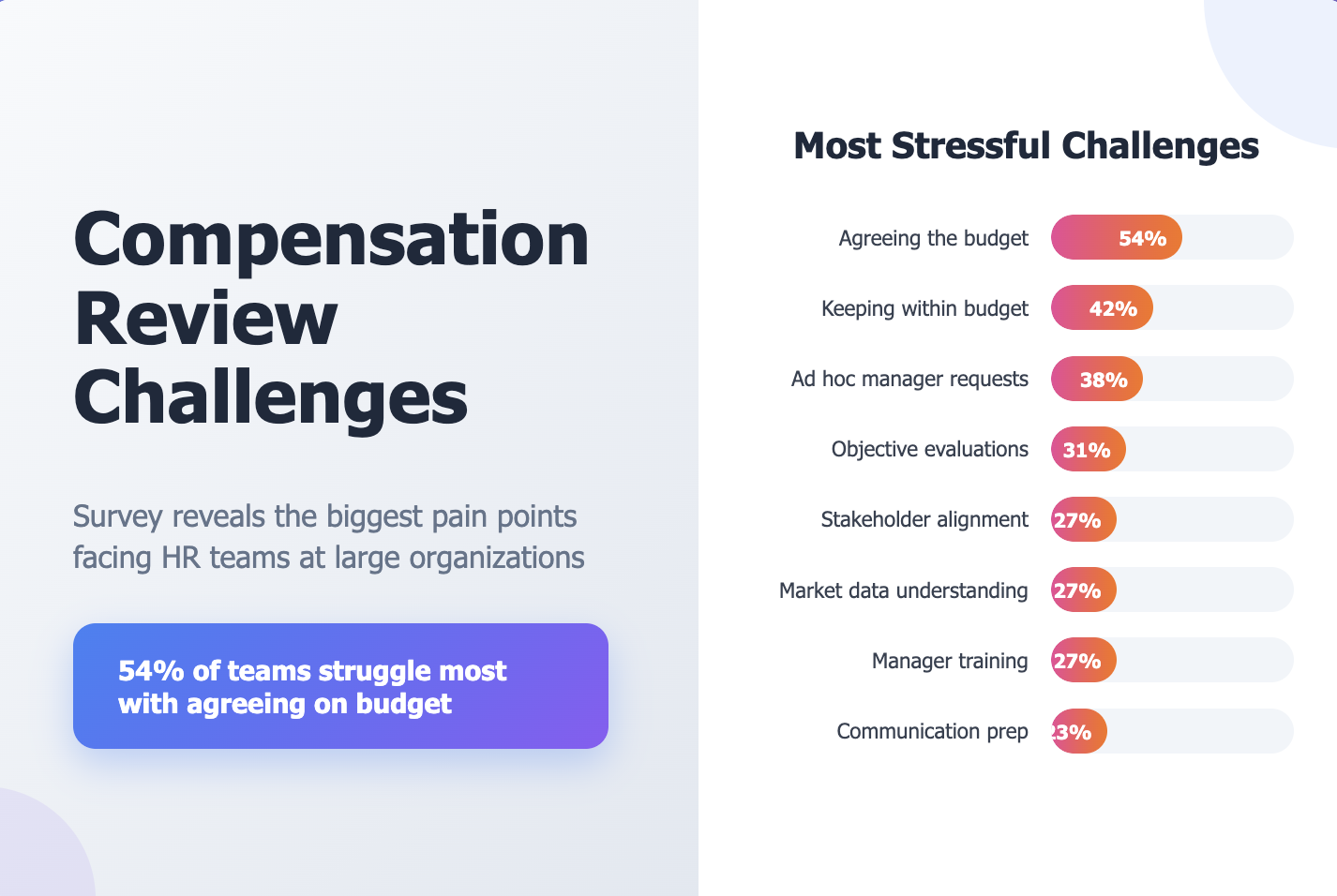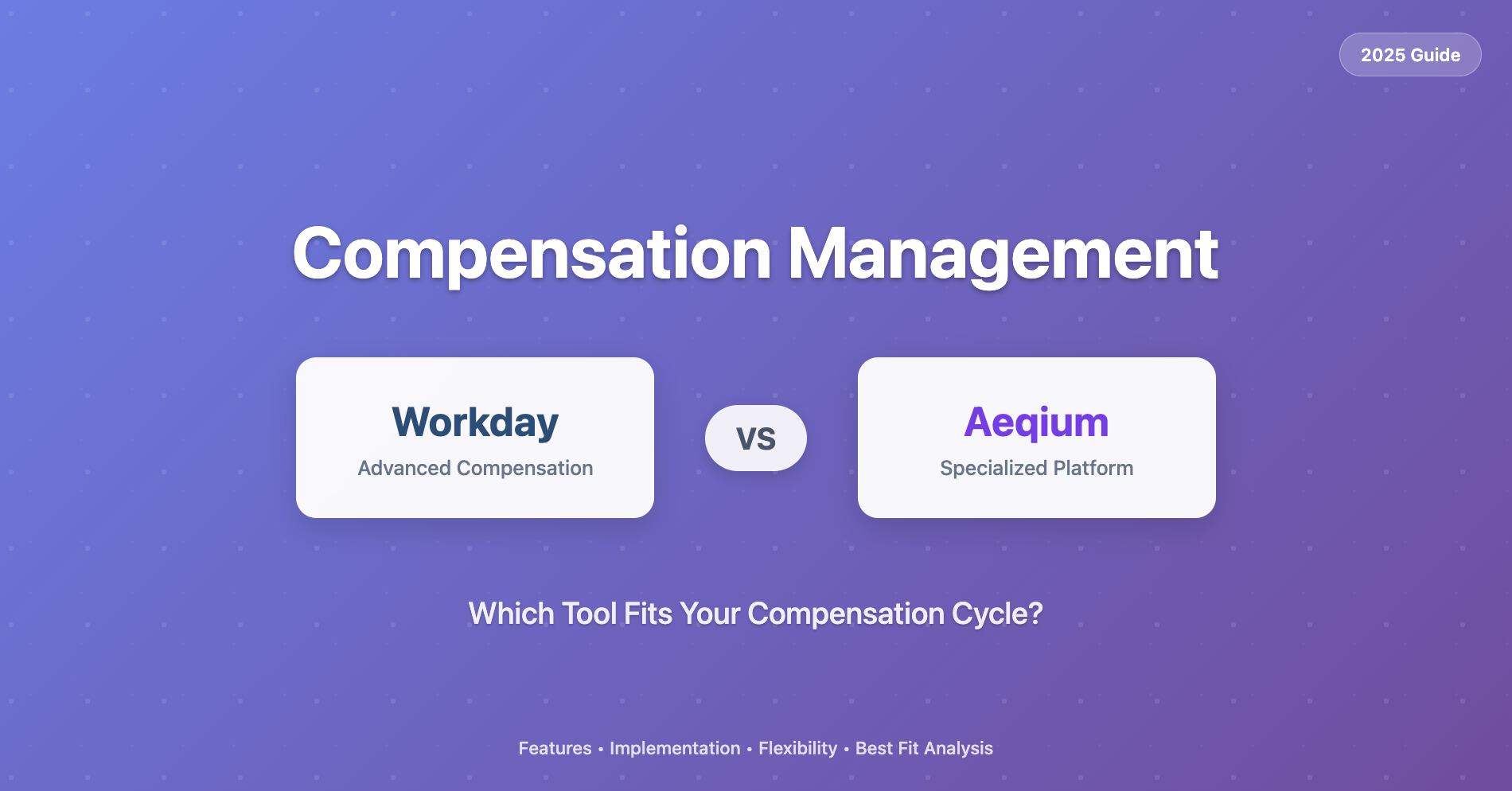Merit Cycles Made Easy: 5 Tips and 3 Tools for Faster, Easier Merit Cycles

In today's competitive talent market, merit cycles are crucial in recognizing and rewarding employees for their valuable contributions. At the same time, many HR teams and managers face major challenges managing these cycles as they’re stuck with clunky workflows and limited insight. It’s all frustrating for HR teams and the managers attempting to review their employees and get back to their other projects.
This blog shares practical tips and tools to help you run faster, easier merit cycles, ensuring fair rewards and boosting company performance. Get ready to transform your merit cycles and create a culture of excellence in your organization.
The Importance of a Well-Structured Merit Cycle
A well-structured merit cycle is vital in nurturing a culture of excellence and maintaining pay equity within your organization. Here are some key reasons why implementing an effective Merit Cycle is essential:
- Motivation and Engagement - Employees feel motivated to perform at their best when their efforts are acknowledged and rewarded fairly. The merit cycle is a powerful incentive for employees to enhance their skills and contribute positively to the company's growth.
- Retention of Top Talent - In a competitive job market, retaining top-performing employees is crucial for sustained success. A well-planned merit cycle keeps key talent on board by offering them competitive compensation that matches their contributions.
- Organizational Performance - By linking individual performance to organizational goals, the merit cycle ensures that every employee's efforts align with the company's vision. This alignment results in improved organizational performance and efficiency.
5 Tips for Faster, Easier Merit Cycles

1. Create and document a well-defined compensation philosophy
Creating a solid foundation is crucial for the success of your merit cycle. Start by defining a well-documented pay philosophy that outlines the reasoning behind pay decisions. Consider benefits, retirement plans, and incentives when rewarding employees. Additionally, establish a transparent job architecture and pay bands to provide a structured framework for compensation decisions. By following these essential steps, you'll be on the path to building a merit cycle that fosters a culture of excellence and fairness within your organization.
2. Clearly define criteria for how and where to apply increases
To ensure a successful merit cycle, take the time to define clear goal outcomes. Whether it's supporting top performers or addressing pay equity gaps across the organization, having well-defined objectives keeps you strategic with your budget and enables you to guide managers effectively in evaluating employees for raises.
Here's what you can do:
1. Define Clear Goals:
- Determine the specific objectives you want to achieve through the merit cycle.
- Concrete goals are essential, whether it's rewarding top performers, fostering teamwork, aligning with company values, or other factors.
2. Document Criteria for Raises:
- Ask yourself and your team what the basis for raises will be.
- Document whether you'll focus on individual or team goals, role proficiency, performance scores, company values, tenure, or a combination of factors.
- Doing this removes subjectivity from the process and ensures evaluating employees consistently.
3. Integrate Logic into Merit Cycle Tools:
- Use your merit cycle tools to incorporate these defined goals and criteria.
- Having guidelines embedded in the tools will empower managers to make confident and objective decisions.
Setting clear goals and criteria creates a more transparent and fair merit cycle that motivates employees and supports your organization's growth.
3. Prioritize manager training on your merit cycle process
Effective communication about compensation and continuous training are vital in preparing your managers for the merit process. Equipping them with a firm grasp of your compensation philosophy and providing clear instructions on their roles streamlines the cycle, fostering increased employee confidence in the company.
A smooth and punctual merit cycle brings forth better compensation outcomes for the company and its employees, further bolstering confidence in management.
To ensure success, consider these steps:
1. Multichannel Training Approach:
- Utilize various communication channels such as emails, articles, visual aids, and lunch-and-learn sessions for comprehensive training.
- This diverse approach ensures managers receive the necessary information effectively.
2. Develop a Comprehensive FAQ Document:
- Create a comprehensive FAQ document to address common employee questions and concerns.
- This resource helps maintain consistency in messaging and prepares managers for handling sensitive conversations.
4. Refresh your pay bands and compare to current employee pay levels
Continuous monitoring of employment and salary data is a valuable practice to gauge how your organization's pay bands compare to the market. Determining who will have access to this data and how they will obtain it is essential.
Here's how to plan and leverage the data effectively:
1. Identify Data Sources:
- Plan the data sources you'll review to ensure comprehensive insights.
- Determine the utilization of each data source to position your pay bands competitively.
2. Gather Lost-Candidate Feedback:
- Capture feedback from candidates who chose other roles to determine if compensation affected their decision.
- This data goes beyond available market data and helps you remain agile in your compensation strategy.
3. Address Pay Disparities:
- Analyze the data to identify pay disparities within your organization.
- Set thresholds to differentiate between disparities requiring immediate action and those you should address in the next merit cycle.
5. Implement tools to reduce inefficiencies and errors
Several software products are available to deliver precise compensation insights and enhance merit workflows.
These tools automate manual spreadsheet work, visualize employee data, and effectively communicate changes, making the entire process faster, more efficient, and focused on achieving better compensation outcomes.
Embracing these tools streamlines the merit cycle, reducing the chances of human error. Managers gain data-driven insights, enabling them to make more informed decisions about pay raises. With such tools, managers can confidently enhance pay equity and align performance across the company. Notably, compensation planning and analysis tools like Aeqium significantly improves the workflows and outcomes of compensation planning.
Let's look at some of these tools in more detail…
3 Tools to Enhance Your Merit Cycle
1. Compensation Planning Software
Manually downloading and inputting information from your HRIS into custom spreadsheets is time-consuming and error-prone. These spreadsheets don't give your managers clear, objective ideas of how to apply increases across their teams.
Compensation planning software helps HR teams quickly build merit cycles and budgets without errors and visually presents their managers with all the information they need to decide in one place.
- Streamlined Data Collection: The software automatically collects and verifies inputs, significantly reducing errors and ensuring accurate data.
- Custom Logic Configuration: Tailor your merit cycle to match your organization's unique needs and performance evaluation criteria. Configure custom logic for merit, promotion, and market cycles, allowing for precise decision-making.
- Effortless Workflows: Simplify the compensation review process for managers with intuitive and efficient workflows, leading to faster reviews.
- Centralized Employee Data: Access all employee data from one centralized location, ensuring transparency and informed decision-making throughout the review process.
Bonus Offer: Aeqium, a leading provider of compensation planning software, is offering a free merit cycle build for HR or Finance leaders managing cycles for over 200 employees.
2. Total Compensation Analytics
Managing data from multiple HR systems can be challenging, hindering managers from quickly grasping their employees' total rewards history. However, Total Compensation Analytics software helps you analyze your team's current and historic compensation to maintain equity and transparency within the organization.
Here's what you can achieve with Total Compensation Analytics:
- Gain Valuable Insights: Automatically generate insights to identify potential discrepancies or inequalities in compensation. Take proactive steps to address these issues, ensuring a fair and equitable compensation structure.
- Review Equity and Transparency: Utilize Total Compensation Analytics to review equity and transparency across your organization's compensation practices. Align compensation decisions with company values, fostering fairness and promoting a positive work environment.
3. Total Rewards Communication Software
Effective communication is essential to helping your employees understand how you compensate them. Total Rewards Communication software is your solution, offering dynamic and user-friendly experiences that keep employees excited about their contributions.
Here's how these tools elevate your total rewards communication:
- Dynamic and Engaging Experiences: Create visually appealing and user-friendly total rewards experiences for employees. Showcase the full range of benefits and incentives engaging and captivatingly.
- Effortless Personalization: Deliver personalized rewards experiences to employees with just a few clicks. Save time and resources while maximizing the impact of your recognition efforts.
Best Practices for Merit Cycles
Effective merit cycles are crucial for recognizing and rewarding employee contributions in the competitive talent market and establishing a well-structured process that aligns with company goals and maintains pay equity.
Clear goals and criteria for raises and proper training for managers lead to improved compensation outcomes and employee confidence.
Leveraging compensation planning software and Total Compensation Analytics enables streamlined workflows and data-driven insights, while Total Rewards Communication software engages and retains top talent through personalized experiences. Embrace these tips and tools to elevate your merit cycles and foster a culture of excellence in your organization.
The Easiest Step to Improve Your Merit Cycle…
When you request a demo today, we'll build your complete merit spreadsheet in Aeqium's compensation planning platform at no charge. Test it live with your HR team and managers and see how easy it is to power faster, easier merit cycles.





